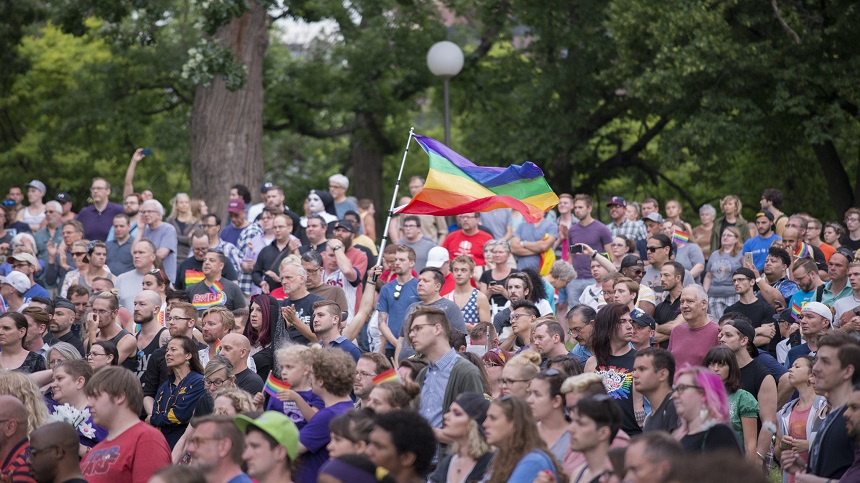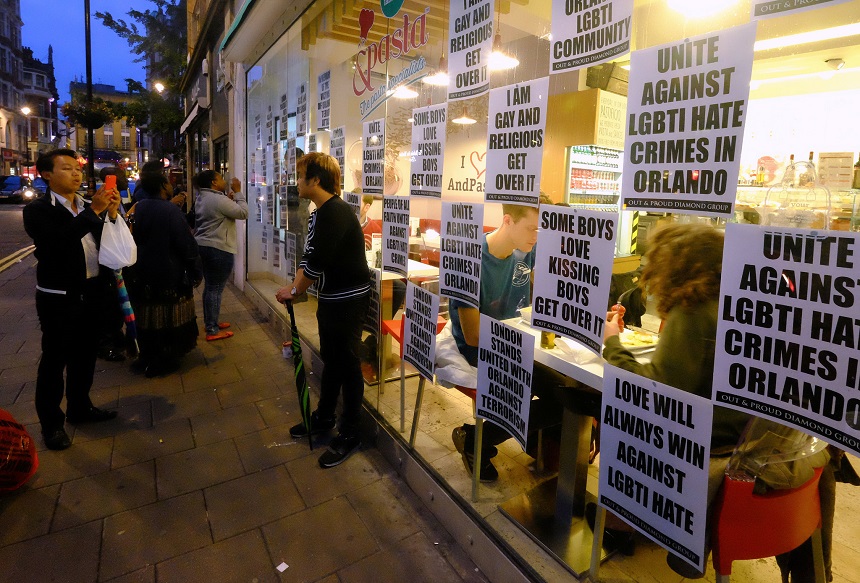
Pulse vigil and rally in Minneapolis on June 12. Fibonacci Blue / Creative Commons
It’s the wrong question based on a wrong set of assumptions, and it’s already leading to the wrong responses, responses sure to keep the violence flowing: anti-queer violence, anti-Muslim violence, racist violence. And it’s sucking up all the air in the ether right now.
I’m on the road in Iowa with my partner and members of her family scattering the remains of her parents who both died last year – in an order and with timing we didn’t expect. So memories and grief and powerful love are all in the mix. I’ve not been on social media much and seen literally no TV these few days, so I came later than many of you to the news. When the words “Orlando” and “Pulse” entered my consciousness, along with an overwhelming surge of shock and anger, along came the grief and powerful love and memories. All of it flowing from chosen relationships tracing to the outlaw and fantastical gifts of queer community and relationships so necessary to my impulse toward liberation and creative wholeness.
How do we understand what took the lives of so many queers, so many young queers of color – young queers and transgender/gender non-comforming people of color are most likely to be criminalized generally in the U.S. – and injured so many others? How do we make sense of a man, come of age in a society permeated with suspicion and animosity directed toward Muslims, who knew a lot about violence and security and weaponry, who somehow felt compelled to enter a gay club and start shooting?

We have to get outside “the hate frame” to have any hope of understanding these things in new ways and begin to fashion new, better responses. Essentially, the hate frame says: 1) Violence is the province of extremists, fanatics, and deranged loners; 2)”Hate violence” directed against marginalized groups is unacceptable to and not tolerated by decent, respectable people and society; 3)Violence is the result of the irrational prejudice – the “hate” – of individuals and groups; and 4)Hate is hate; we need not concern ourselves with the historical and contemporary specifics of how particular groups are targeted for violence. We are told it’s possible to address all of its manifestations with the same tools, primarily more intensive policing, prosecution, and punishment.
The hate frame, then, not only obscures but erases the foundational kinds of violence, fueled by supremacist ideologies and built into the major structures of society, that provide the model for individual/group expressions of “hate” violence. The colonial/American genocide directed against Indigenous peoples, chattel slavery, the massive and ongoing violence of all aspects of policing and the prison industrial complex, the daily violence of economic exploitation – these are the templates. They are not irrational: they seek to consolidate white supremacy, patriarchy, profiteering for the few at the expense of the many, certain forms of religious hegemony. This consolidation ALWAYS advances under the rubric of “safety,” “security,” and a terrible form of competitive claims to victimization.
The hate frame is a distancing strategy that works to convince people that it’s always “someone else” who is responsible for great violence. It’s “them,” the dangerous ones. And who is dangerous in the moment shapeshifts over time, although the roots in white supremacy, patriarchy, and capitalism remain the same. A constant iteration of “enemy, enemy, enemy” against which we must defend ourselves becomes the central framework of society. And so we help to produce the mentality and the means that continue to constrain, control, and kill us.

Thirty-odd years of the hate crime template has produced safety for no marginalized peoples but has led to competitive claims to the need for more policing. It has not helped to ignite serious, ongoing, cross-constituency, cross-movement, cross-issue discussion of structural violence and the supremacist ideologies (hate is a symptom, not the cause) that provide its foundation. And tragically, because this is so, the production of violence, and the foundation of supremacy from which it arises, continues.
To dismantle this ideological and structural vortex, we must employ radical imagination to think differently, more boldly, about our shared humanity – and about what justice could mean in this society, and how it arises or flounders on the integrity of social, economic, cultural, and religious relationships. Laws and courts alone will never produce justice, but will always find ways of leaving structural violence intact; we need cultural strategies, too. To create a different society, we can no longer support the ideologies and structures that demand demons and enemies and wars as the organizing principles for justice.
Related Content
On Orlando: Hate cannot have the first, last or loudest word
After Orlando: Being truthful to who we are, without reservations
Thoughts on Orlando from AFSC staff throughout the region